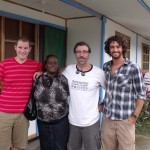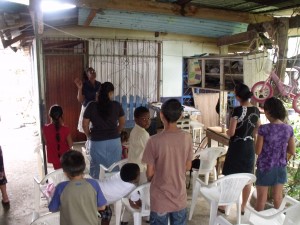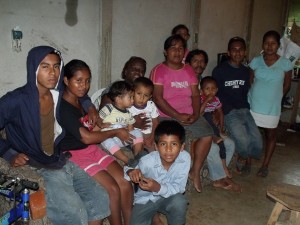There is nothing like sleeping on the floor of the ticketing area of the Charlotte-Douglas International Airport to celebrate a successful field season of collecting preliminary data to inaugurate the Religious Ecology Study (see here, here, & here for previous introductions). Well, my family & a hot shower are in my near future so I shan’t complain too much except to say, is it really too much to make a few extra bucks by renting us $10 cots if you jack us with a 10-hour layover & kick us out of the terminal? Just a thought.

July 2012 research team: University of Alabama PhD student Max Stein, COGOP Pastora Melinda Johnson Dadd, me, Arizona State University grad student Andrew Biship
I won’t be able to share any real meaty findings until I’ve churned thru some of the data we collected, but I can share a little about some of the progress we made & my intuitive sense of things. Our a priori goal was to collect structured interview data about religious & social behavior & infectious disease from an array of congregants in Charismatic churches in 4 neighborhoods that vary in socioeconomic status & rural/urban demographic. I had permission to do this at two Church of God of Prophecy (Iglesia de Dio de la Profecia) locations, one lower SES/rural & one mid-SES/urban, a mid-SES/urban Evangelio Completo, & a mid-SES/urban Tabernaculo de Poder (Tabernacle of Power) My previous estimations of the SES of the urban churches had been that they are lower SES, so we focused our energy on getting another rural/lower SES church involved & resolved to focus initially only on Church of God of Prophecies (COGOP). There were several reasons for this: COGOP has 6 churches & 3 campos (smaller “field” congregations, not big enough to have their own church yet) distributed around Limón Province, my region of interest.
These COGOP churches vary in location & constituency but not doctrine. They are well networked. And our key informant, with whom we stayed, is a pastor at one of the campos (& was until recently also pastor at 2 others) & knows all the pastors & many of the members at all of the churches & campos. So, ultimately, we visited & conducted interviews at every single church & campo save one, with which we tried to connect but just couldn’t. At some locations we were only able to collect 1-2 interviews (for instance, flooding prevented us from reaching a final set of interviewees at one location), but we collected a representative set at least 3 main churches in 4 dispersed locations, including the main COGOP in the province in Limon Centro, a rural location in Limon 2000, one in the tourist town of Puerto Viejo, & one in Sixaola, a border town with Panama.
The research focus was two-fold: (1) to establish a baseline for understanding religious ecology in the region–why people choose the church they choose, what they get out of it, what they put into it, & how this feedback influences relative vitality & success of a church; & (2) to test the hypothesis that cultural diversity & sociality are related to historical or current infectious disease load. With regard to the first focus, we made some superficial observations that the two urban churches we observed in Puerto Limón (the capital city of Limón Province) are vital, whereas many of the others we visited are not. In all fairness, we did not have time to attend a representative sampling of services, which would involve attending them throughout the week for at least a few weeks each. In some cases, we only attended 0-1 service & didn’t have time for more than 2 services at any one location. Future research will involve not only attending a representative sampling but videotaping them as well (ahem–if you are an aspiring grad student in religious ecology, this would make an awesome thesis or dissertation project–I have two camera set-ups & many of the relationships established already!). However, interviews with elders elicited membership information, so I can say with some authority that COGOP Limón Centro & Taberacle of Power in Puerto Limón are thriving congregations &, consistent with this, they have very engaging, active services & demand much of the brethren who choose to become members. On the other hand, many of the rural churches & Puerto Viejo have very few official members & may have only a handful of people at services. For instance, rural locations tend to be attended largely by Nicaraguan immigrants who don’t actually join the churches (many are not allowed because of the requirement that they be legal immigrants with papers) & move around frequently following the banana crops. Puerto Viejo has not had a new member in 3 years & only has 11 active members, who are all middle-aged & elderly women. Services there are relatively short.
With regard to the 2nd focus, that social behavior & cultural diversity would be influenced by infectious disease load, we did not find much concern on the part of the brethren interviewed with regard to infectious disease, socializing, or travel, with one exception. For the most part, our informants were 2nd or 3rd-generation descendents of migrant Jamaican banana plantation workers who settled Limón during the banana republic era or recent Nicaraguan immigrants. However, the exceptional participant who prefers not to travel & expressed more hesitance about multiculturalism is potentially significant, as she is of Bribrí heritage. The Bribrí are an indigenous group from the mountainous Talamanca canton of Limón Province. Though they are just a few minutes from the stoner-tourist hub of Puerto Viejo & are relatively acculturated to the West, they have maintained a population of roughly 12,000 on reservations & nearby un-protected areas of Talamanca & neighboring Panama. Many still speak Bribrí, which belongs to the Chibchan language family, along with Spanish.
Though we did not compare Bribrí religious behavior, preferences, or sociality on this trip, our key informant Melinda Johnson is good friends with several children of the 112-year-old patriarch don Silverio Morales. On a previous trip, she took me to meet his son, don Timoteo Jackson (whose interview about the status of threatening corporate incursions & the complete lack of power the Bribrí have over their own lands should be read here) & daughter doña Philipa Morales (due to be the next head of the matriarchal people, according to Melinda), & this time she took us to meet don Ruben Morales & his family to discuss including them in future research. Ruben & his family were very warm & accommodating, given our friendship with Melinda, & agreed to allow us to include them in future phases with few questions (grad student #2 alert–here’s a way cool opportunity! must speak Spanish & be willing to learn Bribrí). The very large Morales family (Melinda could think of 15 kids of don Silverio & says there are more) live within a few yards of one another, &, in talking to Ruben’s teenage & young adult sons, they have never traveled further than Puerto Limón an hour north & did not seem much interested in doing so. Additionally, the Bribrí are adjacent to another less acculturated indigenous group called the Cabécar, with whom I get the impression they do not frequently interact (though they are are historically related). These impressions are based only on superficial questioning of a few informants who may not be all that reliable. However, it does excite me about the potential for future research in testing this hypothesis…



